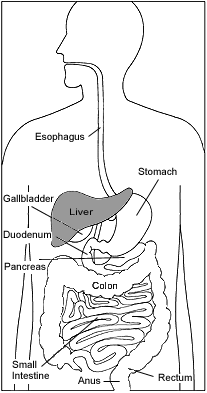Liver Biopsy

The digestive system In a liver biopsy (BYE-op-see), the physician examines a small piece of tissue from your liver for signs of damage or disease. A special needle is used to remove the tissue from the liver. The physician decides to do a liver biopsy after tests suggest that the liver does not work properly. For example, a blood test might show that your blood contains higher than normal levels of liver enzymes or too much iron or copper. An x ray could suggest that the liver is swollen. Looking at liver tissue itself is the best way to determine whether the liver is healthy or what is causing it to be damaged.
Preparation
Before scheduling your biopsy, the physician will take blood samples to make sure your blood clots properly. Be sure to mention any medications you take, especially those that affect blood clotting, like blood thinners. One week before the procedure, you will have to stop taking aspirin, ibuprofen, and anticoagulants.
You must not eat or drink anything for 8 hours before the biopsy, and you should plan to arrive at the hospital about an hour before the scheduled time of the procedure. Your physician will tell you whether to take your regular medications during the fasting period and may give you other special instructions.
[Top]
Procedure
Liver biopsy is considered minor surgery, so it is done at the hospital. For the biopsy, you will lie on a hospital bed on your back with your right hand above your head. After marking the outline of your liver and injecting a local anesthetic to numb the area, the physician will make a small incision in your right side near your rib cage, then insert the biopsy needle and retrieve a sample of liver tissue. In some cases, the physician may use an ultrasound image of the liver to help guide the needle to a specific spot.
You will need to hold very still so that the physician does not nick the lung or gallbladder, which are close to the liver. The physician will ask you to hold your breath for 5 to 10 seconds while he or she puts the needle in your liver. You may feel pressure and a dull pain. The entire procedure takes about 20 minutes.
Two other methods of liver biopsy are also available. For a laparoscopic biopsy, the physician inserts a special tube called a laparoscope through an incision in the abdomen. The laparoscope sends images of the liver to a monitor. The physician watches the monitor and uses instruments in the laparoscope to remove tissue samples from one or more parts of the liver. Physicians use this type of biopsy when they need tissue samples from specific parts of the liver.
Transvenous biopsy involves inserting a tube called a catheter into a vein in the neck and guiding it to the liver. The physician puts a biopsy needle into the catheter and then into the liver. Physicians use this procedure when patients have blood-clotting problems or fluid in the abdomen.
[Top]
Recovery
After the biopsy, the physician will put a bandage over the incision and have you lie on your right side, pressed against a towel, for 1 to 2 hours. The nurse will monitor your vital signs and level of pain.
You will need to arrange for someone to take you home from the hospital since you will not be allowed to drive after having the sedative. You must go directly home and remain in bed (except to use the bathroom) for 8 to 12 hours, depending on your physician's instructions. Also, avoid exertion for the next week so that the incision and liver can heal. You can expect a little soreness at the incision site and possibly some pain in your right shoulder. This pain is caused by irritation of the diaphragm muscle (the pain usually radiates to the shoulder) and should disappear within a few hours or days. Your physician may recommend that you take Tylenol for pain, but you must not take aspirin or ibuprofen for the first week after surgery. These medicines decrease blood clotting, which is crucial for healing.
Like any surgery, liver biopsy does have some risks, such as puncture of the lung or gallbladder, infection, bleeding, and pain, but these complications are rare.
| Fact sheets on other diagnostic tests: |
|
|
[Top]
For More Information
American Liver Foundation (ALF)
75 Maiden Lane, Suite 603
New York, NY 10038
Phone: 1–800–465–4837
1–888–443–7872
or 212–668–1000
Fax: 212–483–8179
Email: info@liverfoundation.org
Internet: www.liverfoundation.org
[Top]
The U.S. Government does not endorse or favor any specific commercial product or company. Trade, proprietary, or company names appearing in this document are used only because they are considered necessary in the context of the information provided. If a product is not mentioned, this does not mean or imply that the product is unsatisfactory.
National Digestive Diseases Information Clearinghouse
2 Information Way
Bethesda, MD 20892–3570
Phone: 1–800–891–5389
TTY: 1–866–569–1162
Fax: 703–738–4929
Email: nddic@info.niddk.nih.gov
Internet: www.digestive.niddk.nih.gov
The National Digestive Diseases Information Clearinghouse (NDDIC) is a service of the National Institute of Diabetes and Digestive and Kidney Diseases (NIDDK). The NIDDK is part of the National Institutes of Health of the U.S. Department of Health and Human Services. Established in 1980, the Clearinghouse provides information about digestive diseases to people with digestive disorders and to their families, health care professionals, and the public. The NDDIC answers inquiries, develops and distributes publications, and works closely with professional and patient organizations and Government agencies to coordinate resources about digestive diseases.
Publications produced by the Clearinghouse are carefully reviewed by both NIDDK scientists and outside experts.
This publication is not copyrighted. The Clearinghouse encourages users of this publication to duplicate and distribute as many copies as desired.
NIH Publication No. 05–4731
November 2004
[Top]
|




